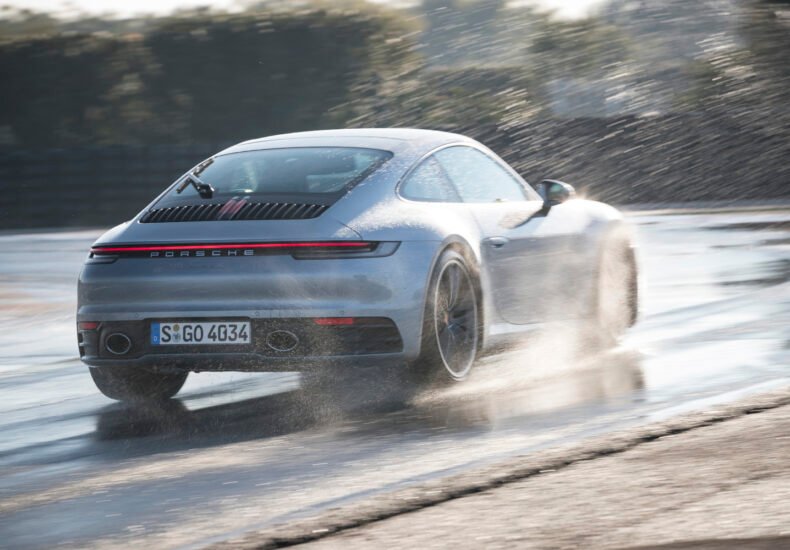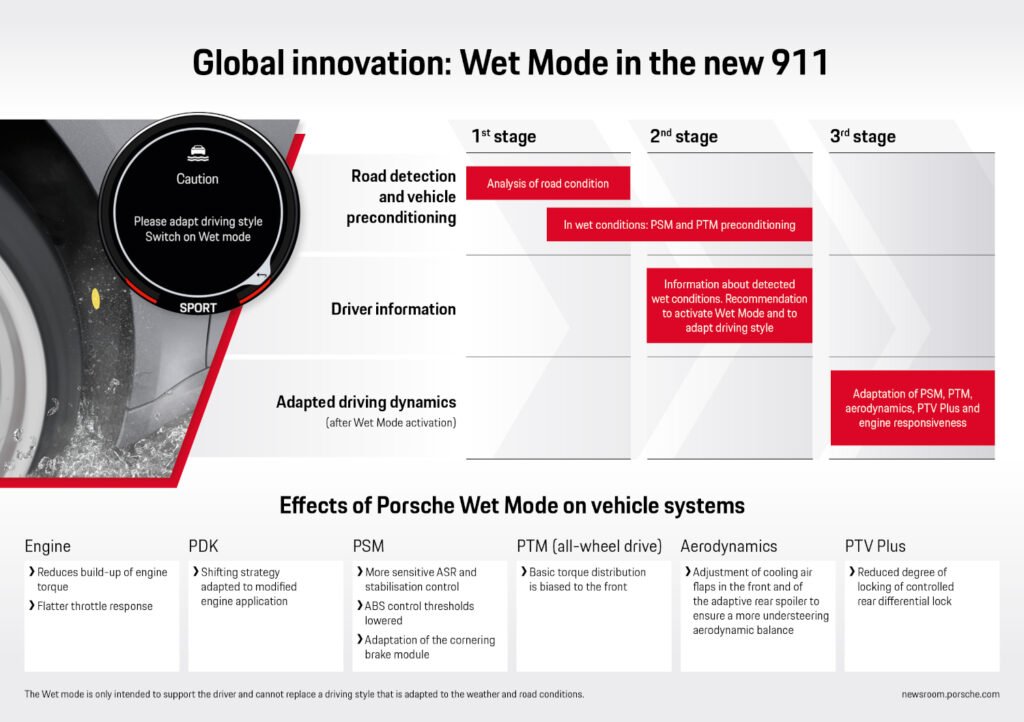
How Porsche Wet Mode Works
The eighth generation (992) Porsche 911 models come as standard with the Wet mode driving assistance system. This innovative assistance system includes a function for detecting significant wet road conditions. This is how Porsche Wet mode works.
How Porsche Wet Mode Works
Porsche Wet Mode can automatically detect wet road conditions. The system uses acoustic sensors in the front wheel housing to detect swirled-up spray water. If the system detects a wet road surface, the response behaviour of the Porsche Stability Management (PSM) and Porsche Traction Management (PTM) systems is preconditioned. Both systems then intervene earlier and more sensitively than before.
In addition, a warning is shown on the display on the right next to the rev counter. This informs the driver of detected wetness and recommends that the driver switch manually to Wet Mode. The corresponding function can be activated in the new button bar above the centre console. It can be integrated in the mode switch on the steering wheel with the optional Sport Chrono Package.
Wet Mode Activated
If Wet driving mode is activated, the PSM, PTM, adaptive aerodynamics, optional Porsche Torque Vectoring (PTV) Plus and drive responsiveness are all adapted to guarantee maximum driving stability. From 90 km/h, the variable rear spoiler is extended to performance position, the cooling air flaps open, the accelerator pedal characteristic is flatter, and the PSM Off function or Sport mode can no longer be activated.
In the wet mode, the torque build-up of the engine is smoother. Also the shift strategy of the new eight-speed PDK transmission is automatically adapted to this. On the all-wheel-drive model, more drive power is transferred to the front axle than in normal mode in order to reinforce the stabilisation effect. Reduced locking ratios of the electronically controlled rear differential lock are also part of the 911 setup for wet conditions.
Wet Mode can also be activated manually on snow-covered roads with reduced grip in order to increased driving stability. Electronic co-pilot can improve handling on slippery surfaces, but it cannot improve grip, so always remember to consider the weather conditions. And as always, drive safe!

Images by Porsche
You may also like
Latest Additions
- Porsche 911 (991.2) Option Codes (MY2017)
 Here are the Porsche 911 (991.2) option codes with descriptions from model year 2017. Options list may vary depending on the year/country
Here are the Porsche 911 (991.2) option codes with descriptions from model year 2017. Options list may vary depending on the year/country - Race Car: Porsche 935 (2019)
 The limited-edition 2019 Porsche 935 clubsport racer pays tribute to the legendary Porsche 935/78 Le Mans race car
The limited-edition 2019 Porsche 935 clubsport racer pays tribute to the legendary Porsche 935/78 Le Mans race car - Michelin Pilot Sport S 5 – Great for Wet Conditions
 Track tyres are usually designed to provide optimal grip in dry conditions. For those drivers who don’t mind a little rain, the Michelin Pilot Sport S 5 is a perfect option for prolonging the track-day season. Michelin Pilot Sport S 5 Jointly developed by Porsche and Michelin, the Michelin Pilot Sport S 5 is a
Track tyres are usually designed to provide optimal grip in dry conditions. For those drivers who don’t mind a little rain, the Michelin Pilot Sport S 5 is a perfect option for prolonging the track-day season. Michelin Pilot Sport S 5 Jointly developed by Porsche and Michelin, the Michelin Pilot Sport S 5 is a - What is the 2023 Porsche 911 Sport Classic?
 The 2023 Porsche 911 Sport Classic is a limited-edition model with distinctive design cues inspired by iconic 911 models from history
The 2023 Porsche 911 Sport Classic is a limited-edition model with distinctive design cues inspired by iconic 911 models from history - Guards Red 2025 Porsche 911 GT3
 Red is a sports car color. But is red a GT3 color? You might say "yes" after checking these images of a Guards Red 2025 Porsche 911 GT3
Red is a sports car color. But is red a GT3 color? You might say "yes" after checking these images of a Guards Red 2025 Porsche 911 GT3 - 2021 Porsche 911 GT3 Cup (992.1) Specs
 Here are the technical specifications of the 2021 Porsche 911 GT3 Cup (992.1) racing car based on the 992.1 generation of the Porsche 911
Here are the technical specifications of the 2021 Porsche 911 GT3 Cup (992.1) racing car based on the 992.1 generation of the Porsche 911 - Race Car: Porsche 911 GT3 RSR (2011)
 For the 2011 season, Porsche unveiled a new version of the Porsche 911 GT3 RSR with extensive modifications
For the 2011 season, Porsche unveiled a new version of the Porsche 911 GT3 RSR with extensive modifications - 2025 Porsche 911 Carrera Cabriolet PDK (992.2) Specs
 Here are the technical specifications of the 2025 Porsche 911 Carrera Cabriolet (992.2) with the PDK transmission
Here are the technical specifications of the 2025 Porsche 911 Carrera Cabriolet (992.2) with the PDK transmission - 2025 Porsche 911 Carrera Cabriolet – 10 Fast Facts
 The 992.2 generation Porsche 911 Carrera Cabriolet was introduced for the 2025 model year. Here are 10 fast facts about the 2025 Porsche 911 Carrera Cabriolet
The 992.2 generation Porsche 911 Carrera Cabriolet was introduced for the 2025 model year. Here are 10 fast facts about the 2025 Porsche 911 Carrera Cabriolet - Porsche Design Chronograph 911 Turbo S (2025)
 Inspired by the new 2026 Porsche 911 Turbo S, Porsche Design has released a new Chronograph 911 Turbo S watch
Inspired by the new 2026 Porsche 911 Turbo S, Porsche Design has released a new Chronograph 911 Turbo S watch
